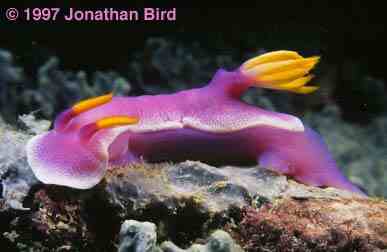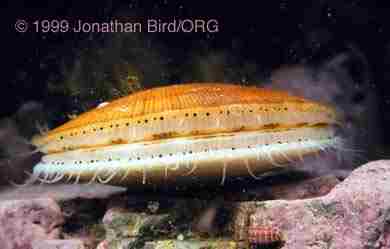
| | You are here : Home > Museums > Mollusks Mollusks 
Mollusc , Mollusca or Mollusk? |
The words "mollusc" or "mollusk" (are both correct) Derived from the Latin word mollis meaning "soft" Study of molluscs, "malacology", comes from the Greek word for soft, malacos. The term "conchology" is also used for the study of molluscs; however, it is usually applied to those that study the shell only. There are over 50,000 known species of Mollusks, which makes them second only to the Arthropods in invertebrate phylum size. Among the Mollusks are some of the most well known of invertebrate sea creatures, like snails, clams, mussels, squid, and octopods. Although one might not see an obvious physical relationship between a snail and a squid, they are remarkably similar in construction. 
In general, mollusks have 3 body regions: a head, a visceral mass, and a "foot." The head contains the sense organs and "brain," while the visceral mass contains the internal organs. The "foot" is the muscular lower part of the body which is in contact with the substrate. Mollusks usually have a shell (although some do not). Mollusks also have an extension of the body wall called the mantle. This portion of the animal's anatomy is responsible for secreting the shell. The mantle encloses the mantle cavity which contains the Ctenidia (gills), anus and excretory pores.
Many mollusks have a radula, a tongue of sorts, which is rough like sandpaper and is used to rasp away at food. The radula is made of a hard material called chitin, the same material of which Arthropod exoskeletons are made. In addition, some Mollusk radulae are impregnated with magnetite to give them superior wear characteristics.
Mollusks have well developed body organs (nervous system, circulatory system, respiratory system, etc.) but lack body segmentation.
There are seven classes of Mollusks: Monoplacophora, Polyplacophora, Aplacophora, Gastropoda, Scaphapoda, Bivalvia and Cephalopoda. Of these, Monoplacophora, Aplacophora and Scaphapoda are rare and/or extremely deep-water creatures, and will not be discussed.

 The Class Gastropoda The Class Gastropoda
The class Gastropoda (meaning "stomach-foot") contains about 70% of the Molluscan species (around 35,000). These are the familiar snails, limpets, nudibranchs and abalones. The snails, limpets and abalones have a shell while the slugs and nudibranchs do not. There are a small number of land Gastropods such as some snails, slugs, etc.
 The Class Polyplacophora The Class Polyplacophora Members of the class Polyplacophora (meaning "many-plated") are more commonly called the chitons (pronounced Kie-tuns). These creatures have eight plates and outwardly resemble the "pill-bugs" which are common under logs and rocks in the forest (they are not related, however). Chitons crawl along rocks and forage for food (mostly algae) using their radulae to scrape it off of the substrate. Magnetite is used for hardening the teeth of the radula in chitons, so they can scrape coraline algae off of rocks. These teeth are so hard that they can etch glass!
These creatures are extremely slow moving. In a year, a chiton may not move more than ten feet. They can detect the presence of light with primitive eyes embedded in the shell plates.
 The Class Bivalvia The Class Bivalvia
The bivalves (meaning "two-shells") are perhaps the most well known mollusks simply because of their history as a source of food. Clams, mussels, oysters and scallops are all bivalves. There are about 15,000 known species of bivalve, with about 80% of them being marine (the rest are found in fresh water).
The bivalve may either burrow through the bottom, or attach itself to the substrate with glue-like strings called "byssal threads." Some scallops do not attach themselves because they prefer to be able to swim away with a squirt of water forced from the mantle.
Most bivalves feed by filtering organic particles from water, and therefore do not have a radula. The gills are used in feeding by means of a mucous coating which traps food particles as water passes through them. Some of the giant clams found in the Pacific have symbiotic algae in their mantle tissue, and can utilize the light of the sun to make food, although they still filter feed as well.
The shell is generated by the mantle from the inside. Pearls are made by clams, oysters and mussels when a grain of sand or other small irritant becomes painfully stuck in the mantle of the creature. The bivalve coats the irritant with the same material which is secreted to produce the inner lining of the shell. This makes the irritant smooth, and theoretically, less painful to the bivalve. Although many people think of pearls as coming only from oysters, most bivalves can produce pearls, as well as some snails, like the conch.
 The Class Cephalopoda The Class Cephalopoda
Although we usually think of Mollusks as benthic (bottom dwelling), the cephalopods have taken to a nektonic (swimming), rather than benthic, existence in the ocean.
Squid, octopods, cuttlefish and nautiluses are all members of the class cephalopoda, meaning "head-footed." This term stems from the way a cephalopod's body is constructed. The "feet" (usually called arms or mistakenly called tentacles) are attached to the part of the body containing the eyes (the "head") while the rest of the body is out in front of the head. Thus, the body does not connect directly to the arms.
The cephalopods may not seem very closely related to the other mollusks, but physiologically, they are similar in internal construction. Perhaps the most obvious difference between most cephalopods and other mollusks is the apparent lack of a shell. The octopods do not have shells at all, and the squid have a small chitinized internal shell. Nautiluses are the only Cephalopods with an external shell. Nautiluses are found in the South Pacific and Indian oceans.
Cephalopods have the most well developed nervous systems of all mollusks, as well as the most well developed eye. The cephalopod eye is one of the most notable examples of convergent evolution in all of the animal world, because this eye evolved from a completely different direction than the mammalian eye, yet it turned out to function in almost the exact same way. Cephalopods, therefore, have extremely good eyesight.
This eyesight is well suited for finding prey. The cephalopod then grasps the prey firmly with its arms and eats the prey with a mouth located between the arms. Cephalopods also have a beak, very similar to that of a parrot, used to help bite into prey.
The Blue-Ringed octopus of the South Pacific has a salivary gland which secretes a venom to subdue prey. The venom is so powerful that the bite of this octopus is almost always lethal to a human. Fortunately, it takes a lot of provocation to get an octopus--any octopus--to bite a person.
While the octopus has eight sucker-equipped arms, the squid actually has ten. Eight of the squid arms are of the same length, while the other two are extra long, and are used for helping to grab prey. These two additional arms are called the tentacles.
Cephalopods do share many characteristic molluscan traits with the rest of the creatures in the phylum, such as the presence of a mantle and mantle cavity, a radula in the mouth and a U-shaped digestive tract (useful for a creature in a conical shell, but not necessary for a Cephalopod).
 Octopuses or Octopi? Octopuses or Octopi?
Many people get confused about the proper plural for the word octopus. Octopus is frequently given a Latin plural, yet the word derives its second root from Greek, not Latin (the english "foot" root from Latin is "pod" or "ped", while from Greek it is "pus"). What is the proper plural, anyway? Many say "octopi." The singular looks like a Latin masculine singular, ending in "us," but it really isn't, so pluralizing it to "octopi" is not correct. Most people also mispronounce it as well. If it were "octopi," it would be pronounced "octo-pee" not "octo-pie," and that sounds silly! So, the correct plural is "octopuses," believe it or not. I prefer not to use either of them. Every time you say "octopuses" someone will correct you, and you end up in an argument. So I like to use "octopods," which is the proper plural of the taxonomic order Octopoda, containing the eight-armed cephalopods.
|

